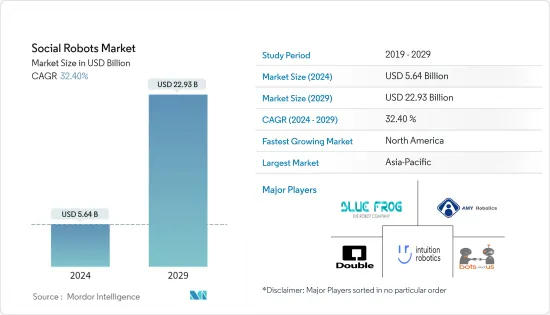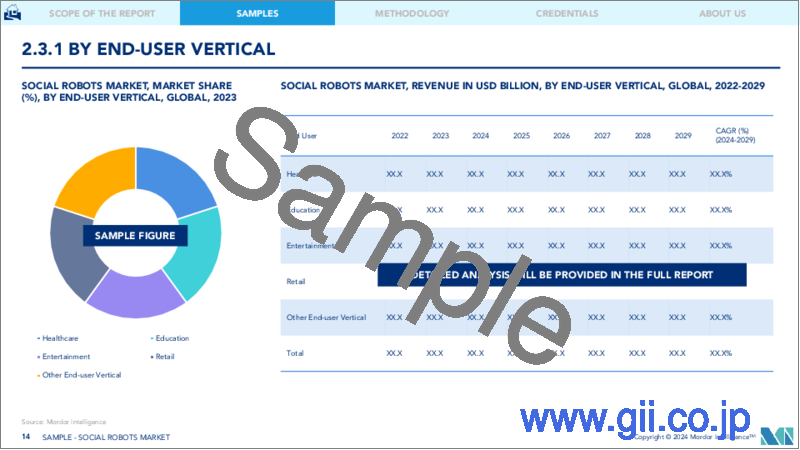|
|
市場調査レポート
商品コード
1440134
ソーシャルロボット:市場シェア分析、業界動向と統計、成長予測(2024~2029年)Social Robots - Market Share Analysis, Industry Trends & Statistics, Growth Forecasts (2024 - 2029) |
||||||
|
● お客様のご希望に応じて、既存データの加工や未掲載情報(例:国別セグメント)の追加などの対応が可能です。 詳細はお問い合わせください。 |
|||||||
| ソーシャルロボット:市場シェア分析、業界動向と統計、成長予測(2024~2029年) |
|
出版日: 2024年02月15日
発行: Mordor Intelligence
ページ情報: 英文 100 Pages
納期: 2~3営業日
|
- 全表示
- 概要
- 目次
ソーシャルロボット市場規模は、2024年に56億4,000万米ドルと推定され、2029年までに229億3,000万米ドルに達すると予測されており、予測期間(2024年から2029年)中に32.40%のCAGRで成長します。

世界がさまざまな分野や用途にわたって先進技術の導入に向けてますます進んでいる中、ロボティクスとオートメーションは人々がロボットと共存できるようにしながら安全を守る上で重要な役割を果たしています。
主なハイライト
- ソーシャルロボットは人間と密接に連携します。したがって、ユーザーに反応し、変化する行動に適応します。数年にわたり、センサー、アクチュエーター、能力が大幅に向上したことにより、人間は顔の表情、アイコンタクト、会話を通じてロボットと自然に対話できるようになりました。大規模な改善の結果、医療業界でのソーシャルロボットの導入に対する関心が高まっています。たとえば、模倣や視線などのソーシャルロボットの行動は、自閉症の子供がロボットと対話する場合と比較して、自閉症の治療にプラスの影響を与えています。
- 高齢者に提供される配慮とケアに対する懸念の高まり、労働力と労働力の需要の拡大は、ソーシャルロボットの導入に影響を与えています。例えば、日本政府は今後数年間で専門労働者が約38万人減少すると予想し、高齢者介護ロボットの開発に資金を提供しています。さらに、世界銀行によると、今後数年間で世界人口の22%が60歳以上になる可能性があります。連携型ロボットの需要は増える一方であり、ソーシャルロボットは儲かる市場になります。
- ロボット工学を学習に使用すると、社会的交流が向上し、幼児間の協力が促進されるため、教室での交流に最適です。ロボットと一緒に遊んだり学んだりすることは、障害のある生徒にとってもさらなる利点となります。ソーシャルロボットの動作は、リアルタイムのコミュニケーションを改善し、ロボットと人間のユーザー間の使いやすさを促進するために開発されています。
- ソーシャルロボットのナビゲーションは、人間の観察や周囲の行動のデモンストレーションから学習するようにプログラムされています。ロボットには、環境を認識できるセンサーとカメラ、およびナビゲーション目標を達成するための実行可能なルートを計算する経路計画システムが装備されています。したがって、これらのソーシャルロボットが提供する支援や指導は、周囲で見ているものシミュレーションであり、同じ人間の行動を模倣します。
- さらに、ソーシャルロボットの主な目的は、物理的なタスクを実行することではなく、人間と対話することです。感染症の拡大に伴い、ソーシャルロボットの潜在的な役割がますます明らかになってきています。ソーシャルロボットは、場合によっては手遅れになるまで診断されない可能性がある複数の一般的な病気に対する意識の高まりと早期診断へのアクセスを通じて社会への負担を軽減するのに役立つため、ソーシャルロボットの需要が高まっています。
- 新型コロナウイルス感染症(COVID-19)のパンデミックは、さまざまな教育やヘルスケアの業務にロボットを採用する人が増え、市場の成長に大きく貢献しました。さらに、これらのロボットはあらゆる病気にかかりやすいため、伝染病を患う患者との統合にも安全に使用できます。そのため、ソーシャルロボットの需要は今後5年間で堅調な成長が見込まれています。
ソーシャルロボット市場動向
ヘルスケア部門が大きな市場シェアを握る
- ソーシャルロボットは、孤独感を軽減し、医師とつながり、活動を監視し、介護者をサポートすることで介護施設を支援します。 2021年 2月、ヴィック財団は調査マニトバと提携して、介護者の負担を最小限に抑え、認知症患者をサポートするための新しいテレプレゼンスロボットプロジェクトを開始しました。
- 2021年7月、米国在宅ケア・ホスピス協会、品質パートナーシップを含む幅広い在宅医療関係利害関係者および消費者団体の支援を受けて、2021年在宅ケア選択法が米国上院で提出されました。 Home Health Care、LeadingAge、AARP、National Council on Agingなど。
- WHOによると、神経障害は2030年に約12%増の1億300万人に増加すると予測されています。神経疾患の増加はリハビリテーションロボットの成長につながっています。このようなロボットは、リハビリテーション演習の動作が毎回同じように繰り返されることを保証し、筋肉だけで活動を実行できるように脳を訓練します。 IBEFによると、2025年までにGDPに占める政府のヘルスケアの割合は2.5%に達するといわれています。
- 2022年8月、ニューハンプシャー大学の研究者は、アルツハイマー病および関連する認知症患者のケアを支援する社会支援ロボットのテストと開発を目的として、NIH(国立衛生研究所)から総額280万米ドルの5年間の助成金を受け取りました。たとえば、患者が薬を期限内に服用しない場合、薬瓶のそばに戦略的に配置されたセンサーが動きの欠如を追跡し、患者が薬を服用しなかったことを示し、支援ロボットに警告します。その後、ロボットは患者に音声によるリマインダーを開始します。数回試行した後、ロボットは遠隔にいる人間の介護者に警告し、患者が薬を飲むことに応じなかった場合に介入することができます。
北米は大幅な成長を遂げる
- パンデミック中の消費者行動の急速な変化により、北米ではデジタル化と自動化への依存度が高まり、その結果、ロボットによる自動化が加速しています。 KUKA AGなど、この分野で事業を展開する企業も同様の動向を示し、北米地域でのソーシャルロボットの成長を推進しました。
- さらに、さまざまなエンドユーザー分野における人工知能、拡張現実などの先端技術の成長により、ソーシャルロボットを導入する新たな機会も生まれています。
- 学生の注意を引くのに役立つソーシャルロボットの導入は、さまざまな地域の教育機関で示されています。最近、米国の30州でロボットを提供している米国に本拠を置く家庭教師ロボットのプロバイダー、Van Roboticsは、チャールストン郡学区(CCSD)の2つの学校で生徒が8台のAbiiロボットを使用していると発表しました。
- このロボットは、1年生から6年生までの生徒を1対1の介入を通じて支援するように設計されています。生徒はそれぞれ固有のログインを取得し、ロボットが個別の指導を提供します。さらに、ロボットは注意力の持続時間を検出し、踊ったり歌ったりすることで子供たちを再び集中させます。ロボットは学生の注意を引き、仲間としての気分を良くするのに役立ちました。
- この地域の人口高齢化は、社会のニーズに応えたいという国民の需要が急速に高まっているため、ヘルスケア現場にも負担をかけています。米国国勢調査局によると、2020年に高齢者人口に占める割合は16.9%であり、今後数年で22%に達すると予想されています。また、カナダ政府によると、今後数年間でカナダの高齢者は950万人を超え、カナダ国民の23%を占めると予想されています。
ソーシャルロボット業界の概要
ソーシャルロボット市場は本質的に非常に競争が激しいです。市場には大小さまざまなプレーヤーが存在するため、非常に集中しています。市場における重要なプレーヤーとしては、Blue Frog Robotics SAS、Haapie SAS、Double Robotics Inc.、AoBo Information Technology、Wonder Workshop Inc.、Amy Robotics、MoviaRobotics Inc.、BotsAndUs Ltdなどが挙げられます。
- 2022年 5月:Intuition Roboticsはニューヨーク州庁と提携し、高齢者の自立を支援するために設計されたソーシャルロボット ElliQを800人以上の高齢者の自宅に導入しました。 ElliQは当初、交友関係と孤独感を和らげることを目的としていました。その後、他の多くの種類の便利な機能がElliQ製品に組み込まれました。人々が目標を達成できるように、愛する人や健康とつながりを保つのに役立つコミュニケーション機能がたくさんあります。
- 2022年 3月:Intuition Roboticsは、ウーバーヘルス、メイヨークリニック、シルバースニーカーと協力して、高齢化するユーザーにとって介護ロボットをさらに役立つものにします。ユーザーはElliQに体調が優れないことや銀行に行くことを伝えることができ、その日と明日を通してフォローアップすることができます。 Intuition Robotics Inc.によると、ElliQは従来の対面サポートを補う別の形式のコンパニオンシップを提供します。他の音声制御ソーシャルロボットデバイスとは異なり、ElliQは明らかに高齢者の自宅での自立をサポートするように作られています。他のテクノロジーはコマンドに反応しますが、ElliQは積極的にアクティビティを提案して会話を開始し、AI(人工知能)を通じてコンテキストを構築して、関係性の感覚を生み出すフォローアップの会話を通知します。
その他の特典
- エクセル形式の市場予測(ME)シート
- 3か月のアナリストサポート
目次
第1章 イントロダクション
- 調査の前提条件と市場の定義
- 調査範囲
第2章 調査手法
第3章 エグゼクティブサマリー
第4章 市場洞察
- 市場概要
- 業界の魅力- ポーターのファイブフォース分析
- 供給企業の交渉力
- 消費者の交渉力
- 新規参入業者の脅威
- 代替品の脅威
- 競争企業間の敵対関係の激しさ
- COVID-19がソーシャルロボット市場に与える影響
第5章 市場力学
- 市場促進要因
- 導入を促進するためのイノベーション予算と補助金の利用可能性
- 高い平均賃金がビジネスリーダーに自動化の選択を促す
- 市場の課題
- アルゴリズムのバイアスに関する複雑さ
- 長期的な関与と予期せぬ結果に関する懸念
第6章 市場セグメンテーション
- エンドユーザー業界別
- ヘルスケア
- 教育
- エンターテインメント
- 小売り
- その他のエンドユーザー業界
- 地域別
- 北米
- 欧州
- アジア太平洋
- 世界のその他の地域
第7章 競合情勢
- 企業プロファイル
- Blue Frog Robotics SAS
- Amy Robotics Co. Ltd
- Double Robotics Inc.
- Intuition Robotics Ltd
- BotsAndUs Ltd
- AoBo Information Technology Co. Ltd
- MoviaRobotics Inc.
- Haapie SAS
- OhmniLabs Inc.
- KOMPAI Robotics
- SZ DJI Technology Co. Ltd
- Embodied Inc. AB
- Wonder Workshop Inc.
- Hanson Robotics Ltd
- Furhat Robotics AB
- Bionik Laboratories Corp.
- AlterG Inc.
- Motorika USA Inc.
- Blue Ocean Robotics ApS
- Matia Robotics(US)Inc.
- Camanio AB
- Kinova Inc.
- Inrobics Social Robotics SLL
第8章 投資分析
第9章 市場の将来
The Social Robots Market size is estimated at USD 5.64 billion in 2024, and is expected to reach USD 22.93 billion by 2029, growing at a CAGR of 32.40% during the forecast period (2024-2029).

As the world is increasingly moving toward advanced technology adoption across a range of sectors and applications, robotics and automation play a crucial role in safeguarding people while enabling them to co-exist with robots.
Key Highlights
- Social robots work closely with humans; hence, they respond to the users and adapt to changing behaviors. Over several years, the massive improvements in sensors, actuators, and abilities have allowed humans to naturally interact with robots through facial expressions, eye contact, and conversation. As a result of the massive improvements, there has been a rise in interest in deploying social robots in medical industries. For instance, the behaviors of social robots, including imitation, and eye gaze, have impacted autism therapy positively compared to children with autism interacting with the robots.
- Increasing concerns about the attention and care offered to the elderly and the expanding need for workforces and labor have influenced the adoption of social robots. For instance, the Government of Japan anticipated a decline of specialized workers of about 380,000 in the next few years and has been funding the development of eldercare robots. Furthermore, according to the World Bank, 22% of the world population may be older than 60 in the next few years. The demand for allied robots is only going to increase, thus making social robots a lucrative market.
- Using robotics in learning is ideal for classroom interaction, as it improves social interaction and encourages collaboration among young children. Playing and learning with robots also offer additional benefits for students with disabilities. Social robot behaviors are developed to improve real-time communication and facilitate user-friendliness between robots and human users.
- Social robot navigation is programmed to learn from human observations or demonstrations of behavior around them. Robots are equipped with sensors and cameras that allow them to perceive the environment and a path-planning system to compute a feasible route to achieve the navigation goal. Hence, the assistance or guidance these social robots offer is a simulation of what they see around them and mimics the same human behavior.
- Additionally, the primary purpose of a social robot is not to perform physical tasks but to interact with humans. As epidemics escalate, the potential roles of social robots are becoming increasingly apparent. The demand for social robots is increasing as they help reduce strain on society through growing awareness and access to early diagnosis of multiple common diseases that, in some cases, can go undiagnosed until it's too late.
- The COVID-19 pandemic significantly contributed to the market growth as people increasingly adopt robots for various educational and healthcare tasks. Moreover, as these robots are prone to any diseases, they can be safely used for integrating with patients having contagious diseases. As such, the demand for social robots is anticipated to robust growth over the next five years.
Social Robots Market Trends
Healthcare Sector to Hold Significant Market Share
- Social robots assist care homes by reducing loneliness, connecting with doctors, monitoring activities, and supporting caregivers. In February 2021, Vic Foundation partnered with Research Manitoba for a new telepresence robot project to minimize the burden on these caregivers and support individuals living with dementia.
- In July 2021, Choose Home Care Act of 2021 was introduced by the Senate in the United States with support from a broad range of stakeholders in-home health care and consumer organizations, including the National Association for Home Care and Hospice, the Partnership for Quality Home Health Care, LeadingAge, AARP, the National Council on Aging, among others.
- According to WHO, neurological disorders are projected to increase to 103 million in 2030, approximately a 12% increase. The increase in neurological disorders is leading to the growth of rehabilitation robots. Such robots ensure the movement in rehabilitation exercises is repeated in the same way each time, training the brain to enable muscles to carry out the activities alone. By 2025, the government healthcare expenditure as a share of GDP is said to reach 2.5%, according to the IBEF.
- In August 2022, Researchers at the University of New Hampshire received a five-year grant totaling USD 2.8 million from the NIH (National Institutes of Health) to test and develop social assistive robots to aid in the care of individuals with Alzheimer's disease and related dementia in the comfort of their own homes. For instance, if a patient does not take the medication in time, a sensor strategically placed by their pill bottle would track the lack of movement, indicating the patient did not take their medicine and alert the assistive robot. The robot would then initiate a vocal reminder to the patient. After a few attempts, the robot would alert a remote human caregiver who could intervene if the patient did not respond by taking their medicine.
North America to Witness Significant Growth
- With the rapid shift in consumer behavior during the pandemic, there is a lot of dependence on digitization, and automation in North America, resulting in the acceleration of robotic automation. The companies operating in this sphere, such as KUKA AG, also witnessed similar trends, propelling social robots' growth in the North American region.
- In addition, the growth in advanced technologies, such as artificial intelligence, augmented reality, and others, in different end-user verticals also creates new opportunities for adopting social robots.
- The adoption of social robots has been witnessed in various regional educational institutions as they help capture students' attention. In recent times, Van Robotics, a US-based provider of tutoring robots that provides its robots in 30 states in the United States, announced that students are using eight Abii robots at two Charleston County School District (CCSD) schools.
- The robots are designed to help students in grades 1 through 6 through one-on-one intervention. Students each get a unique login, and the robots provide personalized instruction. Moreover, the robots detect attention spans and refocus children by dancing and singing. The robots have helped gain students' attention and make them feel better as companions.
- The aging population in the region is also putting strain on the healthcare setting due to the rapidly growing demand from the public to keep up with societal needs. According to the United States Census Bureau, the share of the old-age population accounted for 16.9% in 2020 and is expected to reach 22% in the next few years. Also, according to the Canadian government, seniors in Canada will number over 9.5 million in the next few years and makeup 23% of Canadians.
Social Robots Industry Overview
The social robots market is very competitive in nature. The market is highly concentrated due to the presence of various small and large players. Some of the significant players in the market are Blue Frog Robotics SAS, Haapie SAS, Double Robotics Inc., AoBo Information Technology Co. Ltd, Wonder Workshop Inc., Amy Robotics Co. Ltd, MoviaRobotics Inc., BotsAndUs Ltd, and many more.
- May 2022: Intuition Robotics partnered with the NY State Office to put ElliQ, a social robot designed to help older adults gain independence, in the homes of more than 800 older adults. ElliQ was initially intended to help with companionship and loneliness. Later, a lot of other sorts of helpful features were built into the ElliQ product. Lots of communication features to help people stay connected to their loved ones and health and wellness so they can achieve their goals.
- March 2022: Intuition Robotics collaborates with Uber Health, Mayo Clinic, and Silver Sneakers to make care robots more helpful for users aging in place. The users can tell ElliQ that they are not feeling well or going to the bank and can follow up throughout the day and tomorrow. According to Intuition Robotics Inc., ElliQ offers another form of companionship, supplementing traditional, in-person support. Unlike other voice-controlled social robot devices, ElliQ is explicitly made to support independence at home for older adults. While other technologies are reactive to commands, ElliQ proactively suggests activities and initiates conversations, building context through AI (artificial intelligence) to inform follow-up conversations that create a sense of relationship.
Additional Benefits:
- The market estimate (ME) sheet in Excel format
- 3 months of analyst support
TABLE OF CONTENTS
1 INTRODUCTION
- 1.1 Study Assumptions and Market Definition
- 1.2 Scope of the Study
2 RESEARCH METHODOLOGY
3 EXECUTIVE SUMMARY
4 MARKET INSIGHTS
- 4.1 Market Overview
- 4.2 Industry Attractiveness - Porter's Five Forces Analysis
- 4.2.1 Bargaining Power of Suppliers
- 4.2.2 Bargaining Power of Consumers
- 4.2.3 Threat of New Entrants
- 4.2.4 Threat of Substitutes
- 4.2.5 Intensity of Competitive Rivalry
- 4.3 Impact of COVID-19 on the Social Robots Market
5 MARKET DYNAMICS
- 5.1 Market Drivers
- 5.1.1 Availability of Innovation Budgets and Subsidies to Drive the Adoption
- 5.1.2 High Average Wages Encouraging Business Leaders to Opt for Automation
- 5.2 Market Challenges
- 5.2.1 Complexity Pertaining to Algorithmic Bias
- 5.2.2 Concern Related to Long-term Engagement and Unintended Consequences
6 MARKET SEGMENTATION
- 6.1 By End-user Vertical
- 6.1.1 Healthcare
- 6.1.2 Education
- 6.1.3 Entertainment
- 6.1.4 Retail
- 6.1.5 Others End-user Verticals
- 6.2 By Geography
- 6.2.1 North America
- 6.2.2 Europe
- 6.2.3 Asia-Pacific
- 6.2.4 Rest of the World
7 COMPETITIVE LANDSCAPE
- 7.1 Company Profiles
- 7.1.1 Blue Frog Robotics SAS
- 7.1.2 Amy Robotics Co. Ltd
- 7.1.3 Double Robotics Inc.
- 7.1.4 Intuition Robotics Ltd
- 7.1.5 BotsAndUs Ltd
- 7.1.6 AoBo Information Technology Co. Ltd
- 7.1.7 MoviaRobotics Inc.
- 7.1.8 Haapie SAS
- 7.1.9 OhmniLabs Inc.
- 7.1.10 KOMPAI Robotics
- 7.1.11 SZ DJI Technology Co. Ltd
- 7.1.12 Embodied Inc. AB
- 7.1.13 Wonder Workshop Inc.
- 7.1.14 Hanson Robotics Ltd
- 7.1.15 Furhat Robotics AB
- 7.1.16 Bionik Laboratories Corp.
- 7.1.17 AlterG Inc.
- 7.1.18 Motorika USA Inc.
- 7.1.19 Blue Ocean Robotics ApS
- 7.1.20 Matia Robotics (US) Inc.
- 7.1.21 Camanio AB
- 7.1.22 Kinova Inc.
- 7.1.23 Inrobics Social Robotics SLL




